Text to Speech Celebrity Voices for Perfect Audio
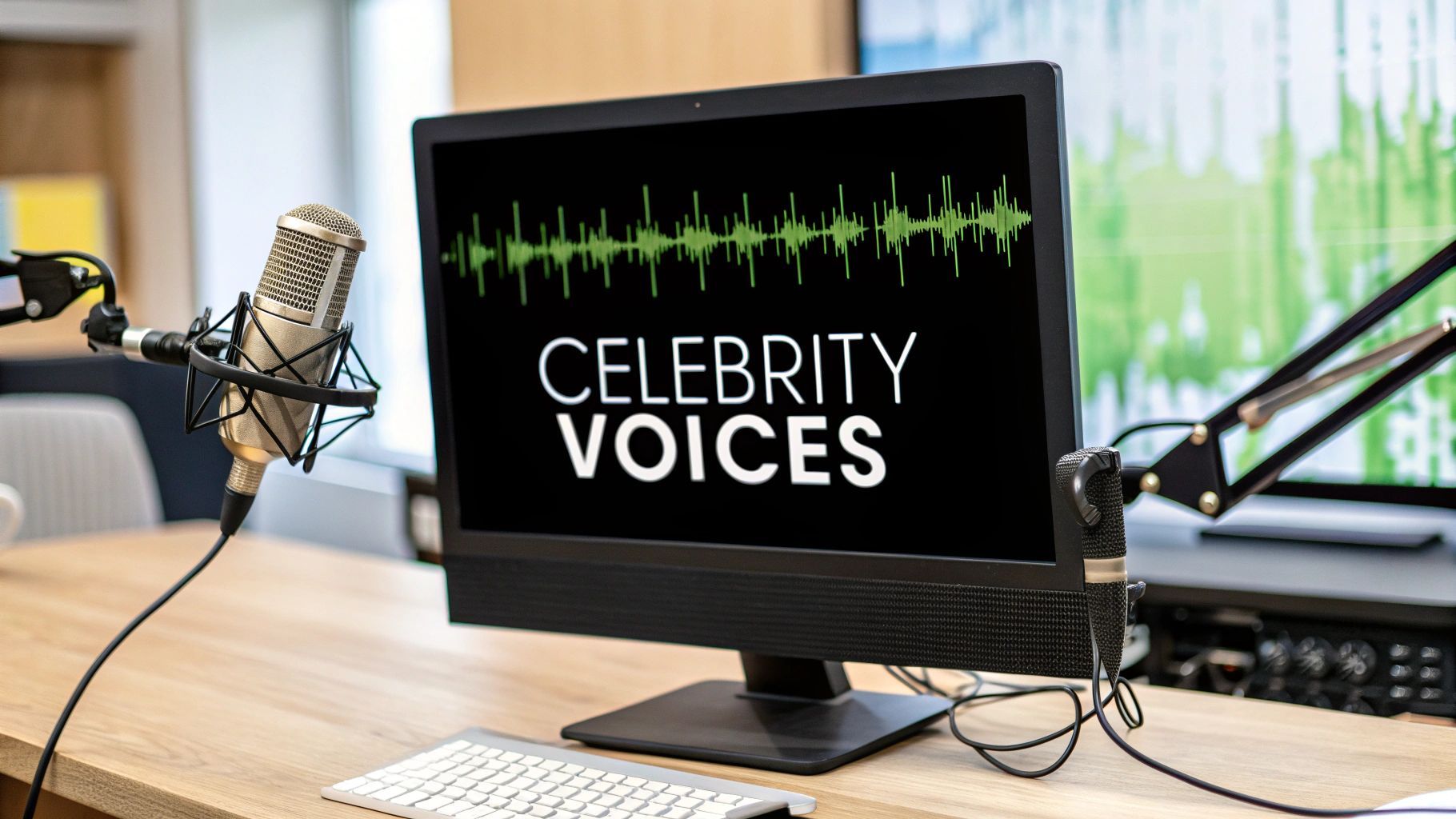
Video Gen Now Faster & Cheaper!


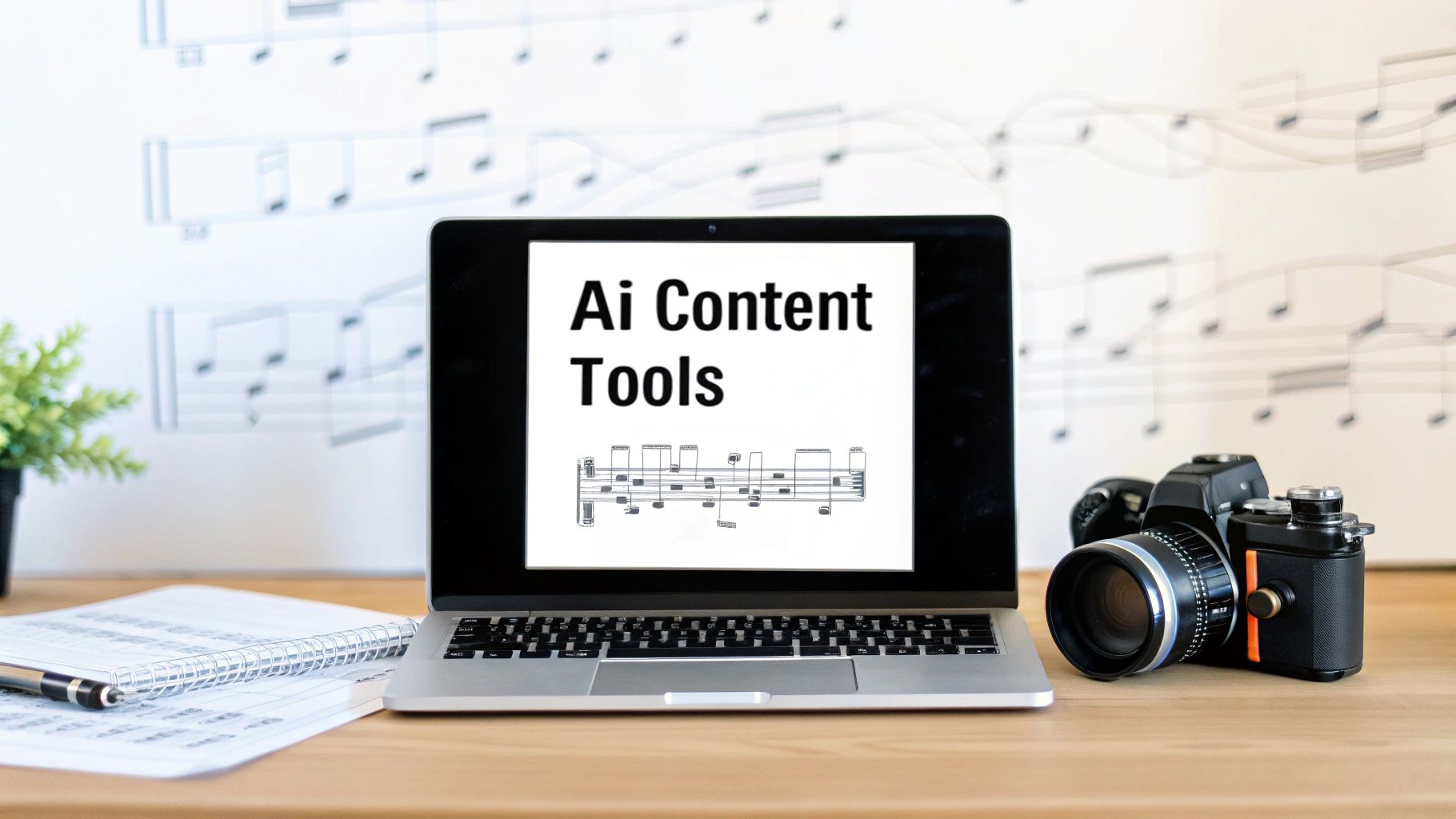
Discover the best AI content creation tools to streamline your workflow. Learn how they work, find the right platform, and unlock new creative possibilities.
Picture this: you have a creative sidekick who never sleeps, never gets writer's block, and can whip up blog posts, eye-catching images, or even personalized videos whenever you ask. This isn't some far-off fantasy; it's what AI content creation tools bring to the table right now. They're like a digital Swiss Army knife for your creative projects, ready to tackle just about any task you throw at them.
So, what are these things, really? At their heart, AI content creation tools are smart software platforms that generate original content—text, images, music, video—from simple instructions you type in, often called prompts. The goal isn't to replace human artists and writers, but to give us a massive boost. Think of AI as a powerful collaborator that helps you smash through creative ruts, speed up your workflow, and explore ideas you never thought possible.
And this isn't just some niche tech for early adopters. It's becoming a serious business. The global market for these tools has already hit around USD 2.15 billion and is expected to explode to nearly USD 10.6 billion by 2033. That incredible jump tells you one thing: everyone, in every industry, is hungry for great content, and they want it fast. If you're curious, you can dig into the data on this market expansion to see what's fueling the fire.
To really get a handle on this, it helps to break down the different flavors of AI creation. Most tools fit neatly into a few main categories, each built for a specific kind of creative work.
The image below gives you a bird's-eye view of the main types of AI tools, splitting them into writing, image, and video.
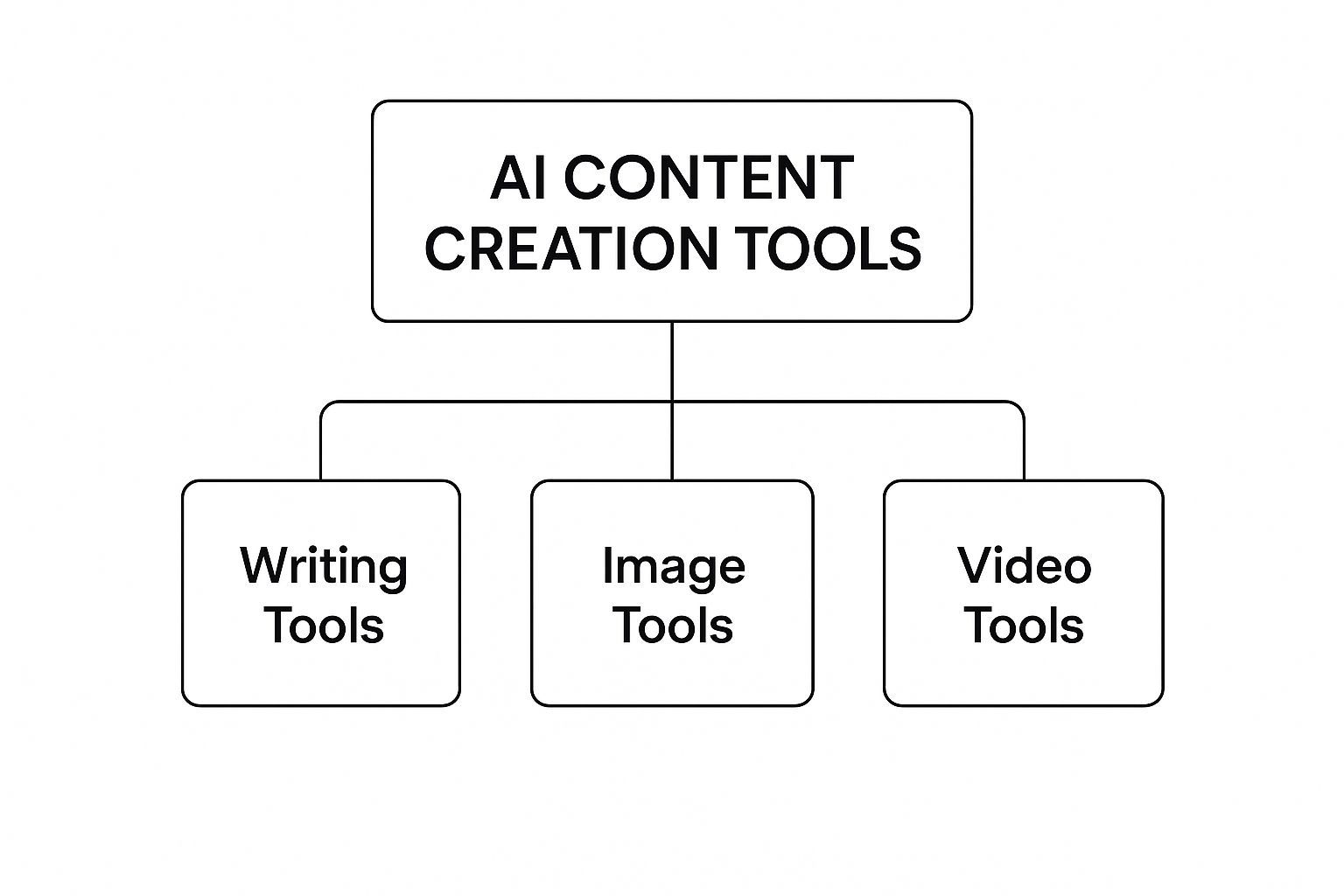
As you can see, whatever you’re trying to make, there's a good chance an AI tool is out there waiting to help—from banging out a quick email to producing an entire video.
The real magic here isn't just the speed. It's how these tools can take a flicker of an idea in your head and turn it into something real in seconds, completely tearing down the old walls between concept and creation.
This guide is your map to navigating this exciting new world. We’ll look at how these tools work their magic, take a deep dive into each category, and help you figure out which platform is the right fit for you.
To get us started, here’s a quick-and-dirty table that sums up the main types of AI tools and what you can do with them.
Tool Category Primary Function Example Use Case Writing Tools Generating written content like articles, emails, and social media posts. Drafting a 1,000-word blog post on a specific topic in minutes. Image Tools Creating original images and artwork from text descriptions. Designing a unique logo or a series of ad graphics for a campaign. Video Tools Producing video content, from simple animations to personalized messages. Creating a personalized birthday video from a celebrity for a friend.
This little cheat sheet gives you a snapshot of the possibilities. Now, let's get into the fun stuff and explore what each of these can really do.
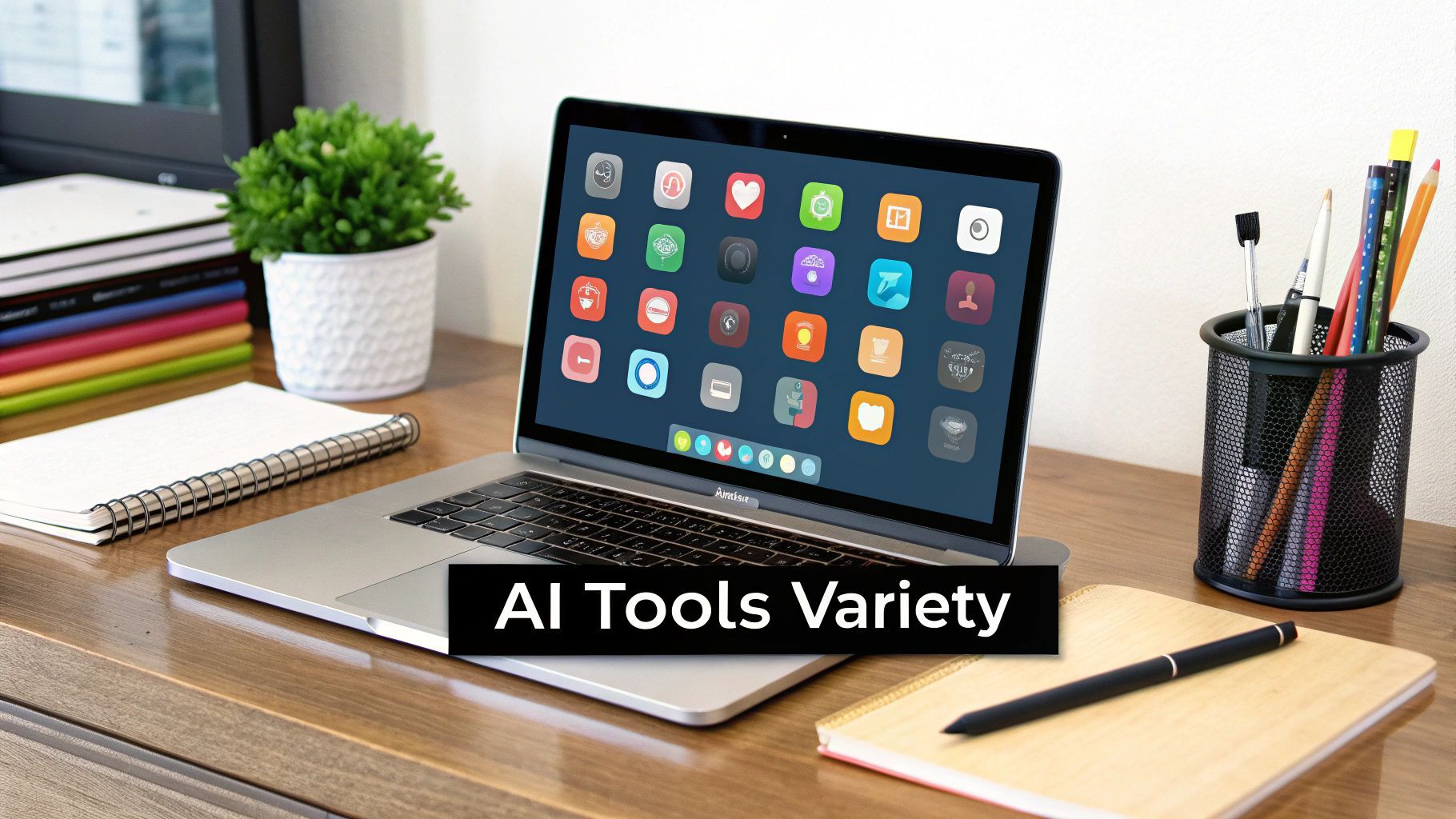
It’s one thing to type a few words and watch an AI whip up a video or a catchy jingle; it’s another to understand what’s going on under the hood. It really does feel like waving a magic wand. But behind the curtain, it's less about hocus pocus and more about a super-intense training regimen that’s frankly brilliant.
Think of it like a creative showdown between a rookie artist and a brutally honest, seen-it-all art critic. This little drama is the essence of a powerful AI technique called Generative Adversarial Networks, or GANs for short.
The “artist,” called the Generator, tries to create something from scratch, like a picture of a dog. It’s never actually seen a dog, but it's been fed a ridiculous amount of data about what dogs generally look like. Its first few attempts? Probably more like abstract blobs than a golden retriever.
This is where our tough “critic,” the Discriminator, comes in. Its entire job is to look at the Generator’s attempt and compare it to a massive library of real dog photos. It then gives its blunt feedback: "Nope, that ain't a dog." This feedback loop happens millions of times, with the artist getting a tiny bit better with each try and the critic getting even harder to please.
This constant back-and-forth is the secret sauce. The Generator keeps refining its work until its creations are so convincing that the Discriminator can't tell the AI's art from a real photo anymore. That’s how an AI learns to create mind-blowingly realistic images, write flowing paragraphs, and even compose a symphony.
For the tools that write for you, the technology is a bit different. It relies on something called Large Language Models (LLMs). The best way to picture an LLM is to imagine a super-nerd who has read, and perfectly remembers, the entire internet. Every blog post, every encyclopedia, every novel, every bad tweet. All of it.
By sifting through literally trillions of words, these models do more than just memorize text. They learn the relationships between words—the subtle dance of context, grammar, style, and tone.
When you feed an LLM a prompt like, "Write a funny email about running out of coffee," it doesn't just search for a pre-made joke. Instead, it predicts the most probable sequence of words that would create a new, funny email on that topic, all based on the patterns it absorbed from its massive reading list.
This predictive power is what makes AI tools so incredibly flexible. They can adopt different personalities because they’ve seen how a CEO crafts an email, how a stand-up comic tells a joke, and how a scientist breaks down a complex idea. The same core idea fuels other types of AI content tools, too.
AI Music Generators: These have "listened" to countless hours of music to internalize melody, harmony, and rhythm. They then generate brand-new musical patterns that sound fresh but familiar. AI Video Generators: They analyze zillions of video clips to master movement, pacing, and scene changes. This allows them to animate a still photo or build a video from scratch by predicting what should happen next.
At the end of the day, these tools aren't "thinking" like you and I. They are unbelievably sophisticated pattern-matching engines trained on a colossal scale. They’re masters of imitation and prediction, just waiting for your instructions to assemble pixels, words, or musical notes into something completely new. The "magic" is just what we see when this high-speed, high-stakes creative battle happens inside the machine.
Jumping into the world of AI content creation tools feels a lot like opening a treasure chest. Inside, you'll find a wild assortment of gadgets, each designed for a specific creative mission. Let's pop the lid and see what’s inside, starting with the written word and moving all the way to eye-popping videos.
And believe me, this isn't just a passing fad. The whole generative AI scene is exploding. It was recently valued at a cool USD 14.8 billion, and experts predict it'll rocket to around USD 80.12 billion by 2030. Why? Because everyone, everywhere, needs more great content, and they need it now.
First up, we have the text generators. These are the bread and butter of the AI toolkit. Think of tools like Jasper or Copy.ai. Forget basic spell-check; these are like having a seasoned copywriter on call 24/7, ready to spin up anything from a punchy tweet to a full-length blog post.
You just give them a topic, tell them what kind of vibe you're going for, and toss in a few keywords. Moments later, you’ve got well-written text ready to go. This is a lifesaver for marketers on a tight deadline, bloggers staring at a blinking cursor, or anyone who needs to sound sharp in an email. When you start looking around, you'll find that top-tier platforms like Writesonic are often mentioned for their powerful writing features.
The real magic is how they obliterate writer's block. An AI assistant can spit out five different blog post ideas before your coffee is even ready. It’s like a jumpstart for your brain.
Next, we wade into the visual side of things with AI image generators. You’ve probably seen the mind-bending creations from tools like Midjourney and DALL-E 2. They take a simple line of text and turn it into a work of art. You can literally type "a photorealistic astronaut riding a horse on Mars," and poof—the AI paints a picture that's never existed before.
These tools are a massive help for:
Marketers who need custom ad creative without blowing their budget on a photoshoot. Designers looking for a spark of inspiration for a new logo or character concept. Creators who are sick of using the same old stock photos for their blogs and social posts.
Being able to conjure up any image you can dream of is completely changing the game.
This is where things get really wild. AI video generation feels like it was plucked straight out of a sci-fi movie. The tools in this space can do some seriously impressive stuff, from making a static photo talk to creating entire videos with lifelike digital hosts.
For instance, platforms like Synthesia let companies produce slick training videos or corporate updates without ever touching a camera or hiring an actor. You just type out your script, pick an AI avatar you like, and the software handles the rest, spitting out a professional-grade video.
Here’s a peek at just how easy it is to get started with a platform like this.
This screenshot gives you a sense of the clean, drag-and-drop style interfaces. It’s all designed so that literally anyone can create a video, no film degree required.
Other tools focus on turning your blog posts or images into short, shareable video clips. This corner of the AI world is moving at lightning speed. If you want to get a better handle on how it all works, our detailed guide on a leading AI video generator breaks it all down. From quick social promos to in-depth tutorials, AI is making video production easier and cheaper for everyone.

Sure, AI can crank out articles and design logos, but some of the most mind-bending ai content creation tools are playing in a totally different sandbox. Forget generic videos. Imagine creating something that stops people in their tracks: a custom message from a celebrity, generated entirely by AI. This isn't just a party trick; it's a wild new frontier of content that mashes up star power with incredible tech.
This is exactly where platforms like SendFame are making waves. They use sophisticated AI to spin up hyper-realistic, personalized video messages from your favorite stars. Think of it as the ultimate digital autograph for our times—a way to get a personal shoutout that feels unbelievably real, and you can do it at scale.
The "wow" factor here is just off the charts. Getting a birthday card is nice. Getting a video where a famous actor wishes you a happy birthday, by name? That’s a whole different universe of awesome. This opens up some crazy fun possibilities for personal gifts and seriously impactful marketing campaigns.
So, what makes an AI celebrity message so different from a standard video tool? It all comes down to a few key ingredients that cook up an experience you just can't get anywhere else.
The most obvious win is the insane level of personalization. Instead of a generic, pre-recorded clip, the AI can weave specific names, dates, inside jokes, or company stats right into the script. A simple "hello" suddenly becomes a one-of-a-kind keepsake.
For instance, a sales manager could generate a video of a famous entrepreneur congratulating their top seller by name and mentioning their exact sales record. The punch that delivers is leagues beyond a standard email blast.
This deep personalization isn't just a cool feature—it's an emotional shortcut. When a message feels like it was made just for you, it creates a memorable connection that generic content can only dream of.
That emotional gut-punch is the second major benefit. Hearing a celebrity you admire deliver a personal message triggers a sense of surprise and pure delight that sticks with you. It’s the kind of thing people get genuinely excited to share.
That brings us to the third perk: massive virality potential. Let's be honest, a personalized video from a star is the first thing you'd post on social media. It's unique, jaw-dropping, and makes for a killer story.
This kicks off a ripple effect, turning a single video into a marketing engine that runs on its own. Businesses can use this for:
High-Impact Announcements: Imagine launching a product with an endorsement from a relevant industry icon. Unforgettable Event Invitations: Build serious buzz by having a famous personality "personally" invite your guests. Next-Level Employee Recognition: Reward your top performers with a shoutout they’ll talk about for years.
The magic behind this involves incredibly advanced voice cloning and video synthesis. AI models are fed countless hours of a celebrity’s speech, expressions, and mannerisms to capture their unique vibe. To really get how the tech works, you can learn more about the process of creating an AI voice actor, which is the soul of these videos.
At the end of the day, AI celebrity messaging isn't just another creative gadget. It’s a whole new way to connect with people by blending the allure of fame with the warmth of a personal note. For anyone trying to create something that truly breaks through the noise, this is one corner of the AI world you'll want to keep your eye on.
So, beyond the fun of making a cat look like a Monet painting or turning a silly sentence into a rock anthem, what's the actual, real-world payoff for using AI content creation tools? It really comes down to three game-changers: speed, scale, and savings. And no, those aren't just empty buzzwords. They're a total reinvention of the creative process.
Think about a small marketing team launching a new product. The old way? Weeks of meetings, agonizing over copy, hiring pricey designers, and maybe even renting a studio for a promo video. It's a marathon of time, money, and manpower.
Now, let's give that same team a little AI magic. They can spitball campaign slogans in minutes. They can draft a dozen unique blog post ideas before lunch. They can generate an entire library of on-brand images for social media while their coffee is still hot. It's not about replacing humans; it's about giving them superpowers.
The first thing you'll notice is the sheer, exhilarating speed. AI tools just vaporize the bottlenecks that usually bog down creative projects.
Beating the Blank Page: Staring at a blinking cursor is the worst. AI is the ultimate cure for writer's block, instantly generating outlines, first drafts, or a list of ideas to get you moving. Warp-Speed Prototyping: Need to see five different ad headlines in action? Want to test ten visual concepts for a campaign? AI can whip these up in seconds, not days, letting you test, learn, and iterate at a dizzying pace. Automating the Grind: All those repetitive tasks like writing social media updates or churning out simple video clips? Hand them over to AI. It frees you up to think about big-picture strategy.
This newfound speed naturally lets you scale your content production to a level you've only dreamed of. You can finally feed all your hungry marketing channels without burning out your team or your bank account. It's no wonder the AI content tools market, currently valued at around US$2.14 billion, is expected to explode to US$7.81 billion by 2032.
To put this in perspective, let's look at how AI stacks the deck in your favor.
This table shows a side-by-side comparison of how much time you can claw back on common creative tasks. The numbers are estimates, but they paint a clear picture of the efficiency gains.
Content Task Traditional Time Estimate AI-Assisted Time Estimate Potential Efficiency Gain Blog Post Draft (1,000 words) 4-6 hours 1-2 hours Up to 75% Social Media Ad Images (5 variations) 3-5 hours 30 minutes Up to 90% Short Promotional Video Script 2-4 hours 15 minutes Over 90% Email Campaign Copy (3 emails) 3-6 hours 1 hour Up to 83%
As you can see, we're not talking about small improvements. AI assistance can fundamentally change your team's capacity, allowing you to reallocate all those saved hours into strategy, refinement, and other high-value work.
But it's not just about doing the same old things faster. These tools crack open entirely new ways to create and connect with people. One of the coolest—and most underrated—perks is hyper-personalization. With AI, you can finally tailor content to individuals at a massive scale, making every message feel like it was written just for them.
The true advantage isn't just efficiency; it's the democratization of creation. Suddenly, a single person can produce the volume and quality of content that once required an entire agency.
AI is also a fantastic wingman for getting your content seen. Many tools are baked with features that help you optimize for keywords and structure your work for search engines. This can be a secret weapon for mastering influencer SEO, pushing your creations in front of a much bigger crowd.
Finally, think of AI as a creative playground. By playing around with different prompts and styles, you start to intuitively understand what makes great content tick. For instance, exploring how AI music is made can spark incredible new ideas for your other projects. It's a place to experiment where the cost of failure is virtually zero.
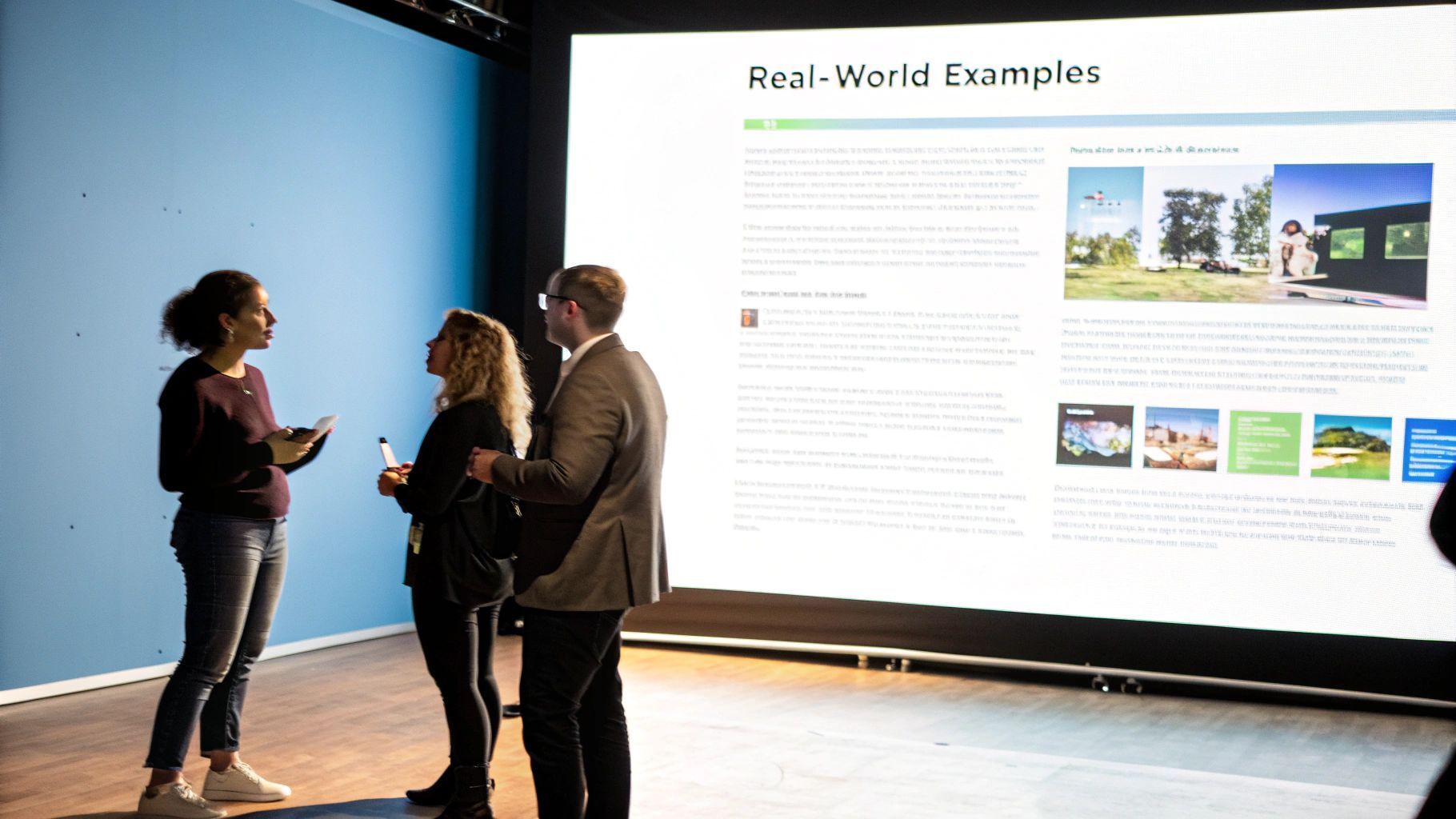
With a whole universe of AI content creation tools popping up, picking the right one can feel like trying to choose just one candy in a giant sweet shop. They all look good, but which one is actually what you need? The secret isn't chasing the tool with the longest feature list. It's about finding the one that perfectly fits your mission.
Think of it like picking a vehicle. Do you need a zippy scooter for quick trips around town (like generating snappy social media captions)? Or are you hauling heavy cargo cross-country and need a semi-truck (like producing a full-blown video campaign)? Each job requires a different ride.
First, get brutally honest about what you want to achieve. What’s the main problem you’re trying to solve? Ignore the shiny objects for a second and focus on the core task.
Are you a writer? You probably want to crush writer's block and pump out articles or copy much faster. Text-based AI is your playground. Are you a visual creator? You need to bring your wildest ideas to life with stunning visuals. AI image generators will be your new best friend. Do you need to make a personal impact? If your goal is to forge a deep, emotional connection with your audience, specialized video tools are the way to go.
Focusing on your core need stops you from paying for a massive, complicated toolkit when all you really needed was a single, perfect wrench.
Next up, how easy is it to actually use the thing? Some platforms are loaded with insane levels of customization but have a learning curve steeper than Mount Everest. Others are delightfully simple, letting you create something amazing with just a click or two. Be honest about how much time you're willing to invest in learning a new system.
And then there's the quality. This is non-negotiable. Always check the AI's output. A text generator that sounds like a robot reading a dictionary or an image tool that churns out wonky, six-fingered hands isn't going to do you any favors. Most tools offer free trials—use them! Kick the tires before you buy the car. When you're weighing your options, check out guides on the best generative search optimization tools to find a perfect match.
Your perfect tool is the one that strikes a balance between power and simplicity, giving you the results you need without requiring a PhD to operate it.
For creators who want to make high-impact content that truly connects, platforms like SendFame are designed for a specific, powerful purpose. It doesn't try to be a jack-of-all-trades. Instead, it masters the art of personalized video messages. It’s not the semi-truck for every job; it’s the sleek, high-performance sports car built to deliver one thing perfectly: a "wow" moment that people will never forget. You can see more examples in our complete guide to AI tools for content creation.
https://www.youtube.com/embed/CRraHg4Ks_g
Jumping into the world of AI content creation tools can feel a bit like exploring a new planet. It’s exciting, a little weird, and you’ve probably got a ton of questions. Let's get them out in the open and tackle the big ones.
The elephant in the room is always the same: is a robot going to take my creative job? The simple answer is no. A better way to think about AI is as an incredibly fast and talented creative partner. It’s the ultimate intern—it can brainstorm a thousand ideas in a second, knock out a rough draft, and handle all the tedious stuff, but it can’t replicate you. It doesn't have your gut feelings, your weird sense of humor, or your unique life experiences.
The real magic happens when a human and an AI team up. You bring the soul, the strategy, and the final touch. The AI brings the muscle and the speed. It’s your vision, brought to life faster than ever before.
This partnership is the future. The AI can assemble the parts, but you’re the one who gets behind the wheel and decides to drive it to the Grand Canyon.
This is a big one, and it’s smart to ask. We’ve all seen the headlines about deepfakes and misinformation, so concerns about originality and ethics are completely justified. The golden rule is simple: use these powers for good. Be upfront when content is heavily AI-driven, especially if it’s for something serious, and always, always add your own creative spin to make it truly yours.
The good news is that the platforms themselves are getting smarter and building in safety features. Still, the creator is always the one in the driver's seat. For instance, using AI to fake a celebrity endorsement is a huge ethical and legal disaster. On the flip side, using a platform like SendFame that works directly and ethically with celebrities to create an amazing personalized video? That’s exactly what this technology was made for.
And now for the question that keeps a lot of people from even trying: "Do I have to be a tech wizard to use AI tools?" I'm happy to report that the answer is a resounding "nope!" You really don't need to be a coding guru. Most of today's AI tools are built to be shockingly easy to use. If you can order a pizza online, you’ve got this.
The interfaces are usually just a text box waiting for your command. It's as simple as this:
Want an image? Type: "A corgi DJing a rave in outer space." Need a video? Type: "Create a motivational speech from a drill sergeant for my team's Monday morning meeting."
The entire point of these tools is to break down creative barriers, not build new ones. They’re designed to give everyone—from a marketing pro to someone just trying to make a legendary birthday wish—the power to create something awesome in minutes.
Ready to make something memorable without the technical meltdown? With SendFame, you can get personalized celebrity videos, custom theme songs, and eye-popping AI images with just a few clicks. Start making content that gets people talking by visiting SendFame.
Create Epic
SendFame